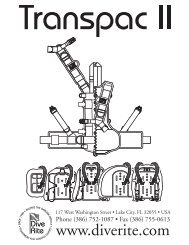You also want an ePaper? Increase the reach of your titles
YUMPU automatically turns print PDFs into web optimized ePapers that Google loves.
5) Oper<strong>at</strong>e the overpressure / rapid exhaust valve (Fig. 11) to be<br />
sure it is functioning properly.<br />
USING THE B/C UNDERWATER<br />
To begin the descent, there is no need to raise your left arm as with<br />
traditional BCs: simply press the "OUT" button on the infl<strong>at</strong>or unit, or<br />
oper<strong>at</strong>e one of the mechanical quick air dump valves by pulling its cord.<br />
During the descent, compens<strong>at</strong>e for the progressive loss of buoyancy by<br />
pressing the "IN" button with your thumb to infl<strong>at</strong>e the BC.<br />
DURING THE ASCENT<br />
To control the speed of ascent, it may be necessary to discharge<br />
some of the excess air.<br />
Use the OUT button, pressing it briefly and repe<strong>at</strong>edly.<br />
In the event of an excessively rapid ascent, a quick air dump can be<br />
obtained by holding down the OUT button.<br />
6) Do not leave the B/C in the sun and do not place or drag it on<br />
rough surfaces th<strong>at</strong> might scrape or puncture it.<br />
WARNING<br />
WHEN USING A BC WITH INTEGRATED WEIGHTS, ALWAYS<br />
SECURE THE UNIT TO A LINE IF YOU ARE PLANNING TO PUT<br />
ON THE BC IN THE WATER. THIS IS BECAUSE, IN CERTAIN<br />
CASES, THE SCUBA UNIT CAN BE NEGATIVELY BUOYANT EVEN<br />
WITH THE BC FULLY INFLATED.<br />
WARNING<br />
Always soak the tank fastening straps before securing the<br />
B/C to the air tank. Failure to do so could allow the tank<br />
to slip out of the B/C strap, causing serious injury or de<strong>at</strong>h.<br />
WARNING<br />
Remember to fully extract the oral infl<strong>at</strong>ion tube before<br />
blowing inside.<br />
WARNING<br />
The rear pockets are sized to accommod<strong>at</strong>e a maximum of 2<br />
kg of weights each.<br />
Refer to your instructor for inform<strong>at</strong>ion about how to make<br />
the most of this fe<strong>at</strong>ure.<br />
FIG. 11<br />
WARNING<br />
When ascending, your buoyancy must be controlled to<br />
avoid too rapid an ascent when approaching the surface.<br />
For inform<strong>at</strong>ion concerning a safe r<strong>at</strong>e of ascent, refer to<br />
a certified diving instructor or your diving <strong>manual</strong>. Follow<br />
your decompression table or diving computer during the<br />
whole ascent. Failure to make a slow, controlled ascent<br />
could lead to serious injury or de<strong>at</strong>h.<br />
WARNING<br />
Do not use your B/C to lift objects in the w<strong>at</strong>er. Should<br />
you drop the object, you could become too buoyant and<br />
your r<strong>at</strong>e of ascent could become too rapid and potentially<br />
dangerous and serious injury or de<strong>at</strong>h could result.<br />
ON THE SURFACE<br />
After returning to the surface, infl<strong>at</strong>e the BC to become positively<br />
buoyant.<br />
WARNING<br />
A B/C is not a safety jacket or personal flo<strong>at</strong><strong>at</strong>ion device<br />
and is not designed to keep the diver on the surface with<br />
head up should he/she become unconscious.<br />
21





